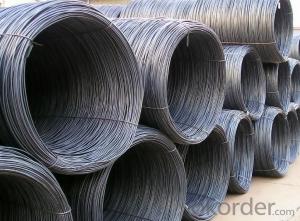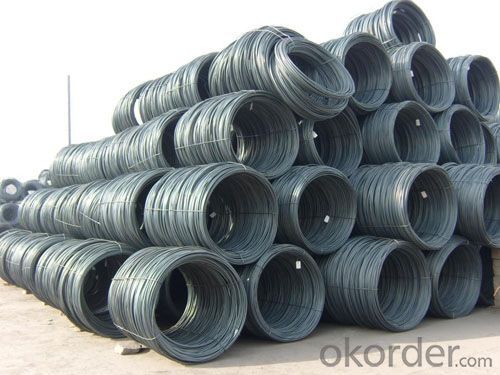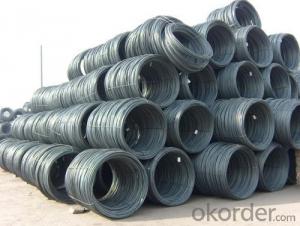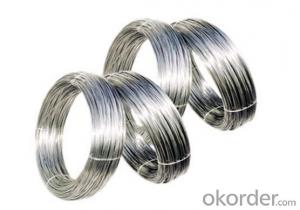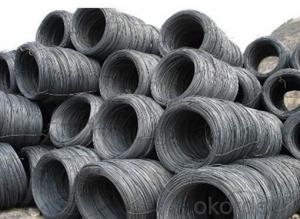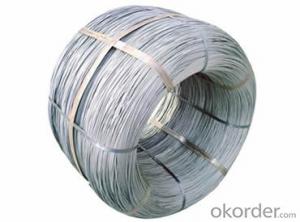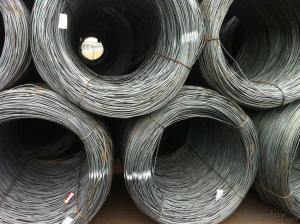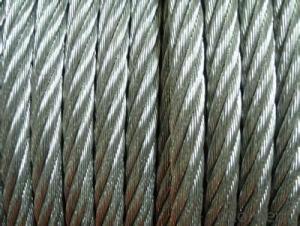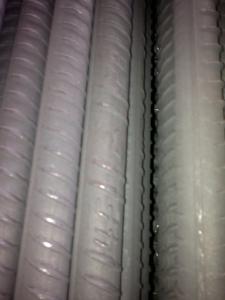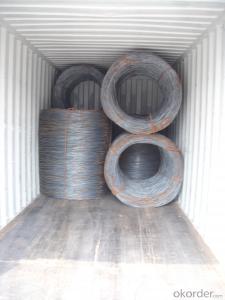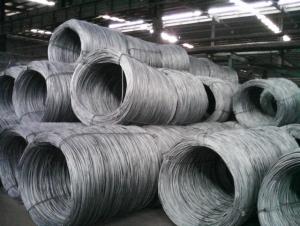Hot Rolled Carbon Steel Wire Rod 8mm with High Quality
- Loading Port:
- China Main Port
- Payment Terms:
- TT or LC
- Min Order Qty:
- 20 m.t.
- Supply Capability:
- 20000 m.t./month
OKorder Service Pledge
OKorder Financial Service
You Might Also Like
Product Description:
OKorder is offering Hot Rolled Carbon Steel Wire Rod 8mm with High Quality at great prices with worldwide shipping. Our supplier is a world-class manufacturer of steel, with our products utilized the world over. OKorder annually supplies products to European, North American and Asian markets. We provide quotations within 24 hours of receiving an inquiry and guarantee competitive prices.
Product Applications:
Hot Rolled Carbon Steel Wire Rod 8mm with High Quality is widely used in construction and manufacturing. Carbon steel wire rod is mainly used for reinforcement of reinforced concrete and welded structure or reprocessed (roberts , nail, etc.) materials, especially used to produce wire drawing, welding electrode, nails, spring, electronic, precise machinery parts and so on.
Product Advantages:
OKorder's Hot Rolled Carbon Steel Wire Rod 8mm with High Quality are durable, strong.packed and suitable for wire mesh,nail manufacture and construction
Main Product Features:
· Premium quality
· Prompt delivery & seaworthy packing (30 days after receiving deposit)
· Can be recycled and reused
· Mill test certification
· Professional Service
· Competitive pricing
Product Specifications:
Manufacture: Hot rolled
Grade: SAE1006 SAE1008 SAE1010 SAE1012 SAE1016 SAE1018
Certificates: ISO, SGS, BV, CIQ
Weight per Coil:2-2.05tons
Packaging: Export packing, packed by coil
FAQ:
Q1: Why buy Materials & Equipment from OKorder.com?
A1: All products offered byOKorder.com are carefully selected from China's most reliable manufacturing enterprises. Through its ISO certifications, OKorder.com adheres to the highest standards and a commitment to supply chain safety and customer satisfaction.
Q2: How do we guarantee the quality of our products?
A2: We have established an advanced quality management system which conducts strict quality tests at every step, from raw materials to the final product. At the same time, we provide extensive follow-up service assurances as required.
Q3: How soon can we receive the product after purchase?
A3: Within three days of placing an order, we will begin production. The specific shipping date is dependent upon international and government factors, but is typically 7 to 10 workdays.
Q4: How many tons can be loaded into one 20ft container?
A4: Around 18—20tons
Q5: What is the chemical composition?
A5:
C:0.10%max Mn:0.32% max S:0.045%max P:0.040%max Si:0.30%max
Images:
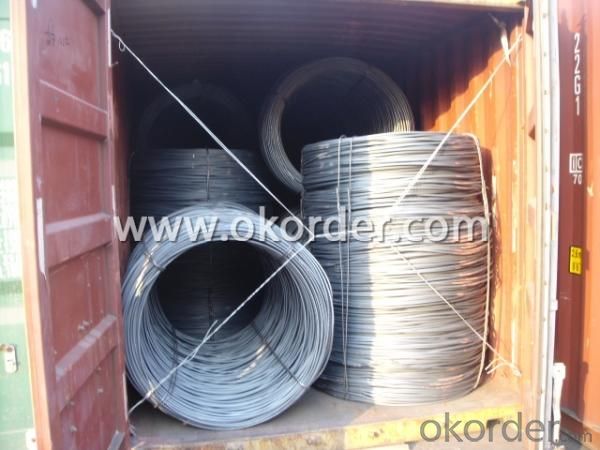
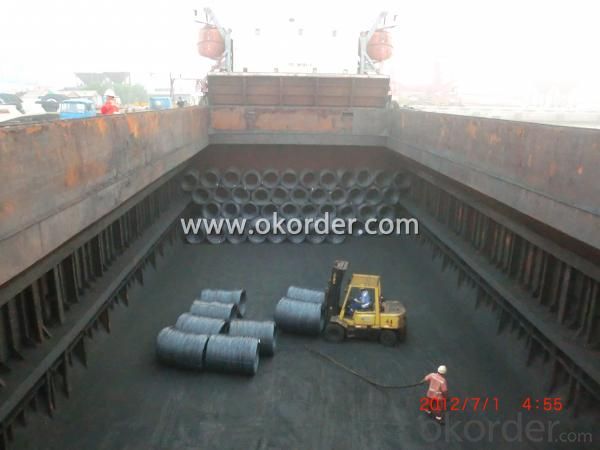
- Q: What are the different types of steel wire rod available?
- There are several different types of steel wire rods available, each with its own unique properties and applications. Some of the common types include carbon steel wire rods, alloy steel wire rods, stainless steel wire rods, and galvanized steel wire rods. Carbon steel wire rods are the most widely used type and are known for their high strength and durability. They are often used in construction, automotive, and manufacturing industries for applications such as reinforcing concrete, making wire mesh, and producing springs and fasteners. Alloy steel wire rods contain additional elements like chromium, nickel, or molybdenum, which enhance their strength, hardness, and resistance to corrosion. These rods are commonly used in the production of high-strength wires, cables, and springs that require superior performance under demanding conditions. Stainless steel wire rods are highly corrosion-resistant and have excellent strength and heat resistance properties. They are commonly used in applications where hygiene, durability, and aesthetics are important, such as in the production of kitchen utensils, medical instruments, and architectural structures. Galvanized steel wire rods are coated with a layer of zinc to provide enhanced corrosion resistance. This type of wire rod is commonly used in outdoor and marine applications, such as fencing, electrical wiring, and fishnets, where exposure to moisture and harsh environments is a concern. In addition to these types, there are also specialty steel wire rods available, such as oil-tempered wire rods used in the production of automotive suspension springs, and cold-heading quality wire rods used for manufacturing fasteners and screws. Overall, the availability of different types of steel wire rods allows for a wide range of applications across various industries, providing strength, durability, and resistance to corrosion as required by specific needs.
- Q: What are the different mechanical properties of steel wire rod?
- The different mechanical properties of steel wire rod include high tensile strength, good ductility, excellent toughness, and high fatigue resistance. Additionally, steel wire rod exhibits low deformation under stress, good formability, and high resistance to corrosion.
- Q: How is steel wire rod tested for surface finish?
- Steel wire rod is tested for surface finish using various methods. One common method is visual inspection, where trained technicians visually examine the rod's surface for any imperfections or defects. Additionally, the rod may undergo surface roughness measurement using instruments such as profilometers to assess the smoothness of its surface. Other tests may include dye penetrant inspection, where a dye is applied to the rod's surface to identify any cracks or surface flaws, or ultrasonic testing, which uses high-frequency sound waves to detect internal and surface defects. Overall, a combination of visual inspection and specialized testing techniques is employed to ensure the desired surface finish quality of steel wire rods.
- Q: How is steel wire rod used in the manufacturing of wire forms for aerospace applications?
- To manufacture wire forms for aerospace applications, steel wire rod is essential. It serves as the starting material for wire drawing, which involves a series of processes to produce wire forms with specific dimensions and characteristics. The first step is to carefully select high-quality steel wire rod that meets the strict standards of the aerospace industry. This ensures that the wire forms will possess the necessary strength, durability, and corrosion resistance required for aerospace applications. Once the suitable steel wire rod is obtained, it is passed through a wire drawing machine with a series of dies. This process involves pulling the wire rod through progressively smaller dies, resulting in a reduction in diameter and an increase in length. Wire drawing not only shapes the wire but also refines its microstructure, leading to improved mechanical properties. Following wire drawing, the steel wire undergoes further processing based on the specific requirements of the wire forms. It may undergo additional treatments such as heat treatment, surface coating, or plating to enhance its performance and meet the rigorous aerospace industry standards. The wire forms produced from steel wire rod find extensive use in the aerospace sector. They are employed in the manufacturing of various aircraft components, including springs, fasteners, connectors, wire harnesses, and control cables. These wire forms play a vital role in ensuring the structural integrity, functionality, and safety of different aerospace systems. The utilization of steel wire rod in the production of wire forms for aerospace applications offers numerous advantages. Steel is renowned for its high strength-to-weight ratio, excellent fatigue resistance, and good electrical conductivity. These properties make steel wire forms ideal for withstanding the demanding conditions experienced in the aerospace industry. In conclusion, steel wire rod is an indispensable raw material in the manufacturing of wire forms for aerospace applications. Through processes like wire drawing and additional treatments, it is transformed into wire forms with the necessary properties to meet the stringent requirements of the aerospace industry. These wire forms significantly contribute to the structural integrity and functionality of various aerospace systems.
- Q: How is steel wire rod used in the manufacturing of wire mesh grilles?
- Steel wire rod is used in the manufacturing of wire mesh grilles as it serves as the primary material for creating the individual wires that form the mesh. The wire rod is first drawn through a series of dies to reduce its diameter and increase its length, resulting in thin and elongated wires. These wires are then woven or welded together to construct the wire mesh grille, providing strength, durability, and a structured pattern that allows for air circulation and visibility while also offering security and protection.
- Q: What is the average price of steel wire rod?
- The average price of steel wire rod can vary depending on several factors including market demand, production costs, and global economic conditions. As of [current year], the average price of steel wire rod ranges from [price range] per metric ton. However, it is important to note that prices can fluctuate significantly over time, so it is always recommended to consult with industry experts or suppliers for the most up-to-date and accurate pricing information.
- Q: What are the different types of wire ropes made from steel wire rod?
- The different types of wire ropes made from steel wire rod include galvanized wire ropes, stainless steel wire ropes, and non-rotating wire ropes.
- Q: What are the common applications of galvanized steel wire rod?
- Galvanized steel wire rod has a wide range of applications across various industries due to its unique properties and benefits. Here are some common applications of galvanized steel wire rod: 1. Construction: Galvanized steel wire rods are extensively used in the construction industry. They are used for reinforcing concrete structures like beams, columns, and foundations. The galvanized coating provides corrosion resistance, making it suitable for outdoor applications where exposure to moisture and harsh weather conditions is common. 2. Fencing and Barriers: Galvanized steel wire rod is commonly used for manufacturing fences, wire mesh, and barriers. The galvanized coating enhances the wire's durability and makes it rust-resistant, ensuring a longer lifespan even in outdoor environments. 3. Automotive Industry: Galvanized steel wire rods are used in the automotive industry for various applications. They are used in the manufacturing of automotive parts like springs, suspension systems, and brake cables. The galvanized coating provides protection against corrosion, ensuring the longevity and reliability of these components. 4. Agriculture: Galvanized steel wire rods find extensive use in the agricultural sector. They are used for making wire fences, trellises, and supports for plants and crops. The galvanized coating protects the wire from rusting, ensuring its durability in agricultural environments that are often exposed to moisture and chemicals. 5. Electrical Wiring: Galvanized steel wire rods are also used in electrical applications. They are used for manufacturing electrical wires, cables, and conductors. The galvanized coating provides an added layer of protection against corrosion, ensuring the safety and longevity of electrical installations. 6. Packaging and Binding: Galvanized steel wire rods find applications in the packaging and binding industry. They are used for making wire ties, baling wire, and packaging materials. The galvanized coating provides strength and durability, making it ideal for securing and bundling different materials. These are just a few common applications of galvanized steel wire rod. Its versatility, strength, and corrosion resistance make it a valuable material across numerous industries and sectors.
- Q: What are the different surface roughness measurement methods for steel wire rod?
- There are several surface roughness measurement methods available for steel wire rod. These methods are utilized to assess the quality and smoothness of the surface finish of the wire rod, which is crucial for various applications such as wire drawing, machining, and coating. Some of the commonly used methods for measuring surface roughness of steel wire rod include: 1. Contact Profilometry: This method involves using a stylus or a probe to physically scan the surface of the wire rod. The stylus moves across the surface and records surface irregularities. The data obtained can be used to calculate various roughness parameters such as Ra (arithmetical average roughness) and Rz (maximum height of the roughness profile). 2. Optical Profilometry: This method utilizes optical techniques to measure the surface roughness. It involves projecting a light source onto the wire rod surface and capturing the reflected light using a camera or other optical sensors. The captured data is then analyzed to determine the roughness parameters. 3. Laser Scanning: Laser scanning is a non-contact method for measuring surface roughness. A laser beam is directed at the wire rod surface, and the reflected beam is analyzed to calculate roughness parameters. This method is highly accurate and provides detailed information about the surface topography. 4. Atomic Force Microscopy (AFM): AFM is a high-resolution imaging technique that can be used to measure the surface roughness of steel wire rod at the nanoscale level. It involves scanning a sharp tip across the surface and detecting the interaction forces between the tip and the surface. The collected data is used to create a detailed topographic image and calculate roughness parameters. 5. Electromagnetic Eddy Current: This method uses electromagnetic fields to measure the surface roughness of steel wire rod. Eddy currents are induced in the wire rod surface, and the changes in these currents are measured and analyzed to determine the roughness parameters. This technique is particularly useful for measuring roughness on conductive materials. Each of these surface roughness measurement methods has its advantages and limitations, and the choice of method depends on factors such as the required accuracy, speed, and the specific characteristics of the steel wire rod being measured.
- Q: How is steel wire rod used in the manufacturing of suspension cables?
- Steel wire rod is used in the manufacturing of suspension cables as it provides strength, durability, and flexibility required to support heavy loads and withstand tension and compression forces. It is commonly used as the core material for suspension cables, as it is capable of bearing the weight of the structure and maintaining its stability. Additionally, steel wire rod is often galvanized to increase its resistance to corrosion, ensuring the longevity of the suspension cables in various environmental conditions.
Send your message to us
Hot Rolled Carbon Steel Wire Rod 8mm with High Quality
- Loading Port:
- China Main Port
- Payment Terms:
- TT or LC
- Min Order Qty:
- 20 m.t.
- Supply Capability:
- 20000 m.t./month
OKorder Service Pledge
OKorder Financial Service
Similar products
Hot products
Hot Searches
Related keywords
